



Livestock and Products Semi-Annual 2010 - EU-27
According to the latest GAIN Report from USDA Foreign Agricultural Service (FAS), bluetongue continues to remain widespread in the European Union, but most commercial herds have acquired immunity through past infections as well as from vaccinations.Executive Summary
After a temporary upturn in 2007 and 2008, the EU cattle herd is forecast to resume its long term trend of contraction. This trend is mainly a result of increasing farm input costs, lagging milk prices, and restricted government support. Calf production in 2008, 2009, and 2010 is adjusted further downwards from the forecast in the Annual Report. Ending inventories as well as slaughter are revised to a lower number accordingly. Since the start of 2008, EU beef imports fell due to sanitary restrictions laid down by the European Commission (EC) on EU beef imports from Brazil. During 2009, EU imports of Brazilian beef were also hampered by the strong Real and the economic slowdown in the EU. It is anticipated that, as in 2008 and 2009, alternative suppliers will not be able to increase their exports to the EU substantially this year. Anticipated higher consumer prices resulting from restricted imports together with the falling beef production and the current global economic situation will further reduce beef consumption.
2009 & 2010 The herd is forecast to resume its long term trend of contraction
During 2007 and 2008, the long term trend of contraction of the cattle herd was temporally halted (see graph below) mainly as a result of the high beef and milk prices.
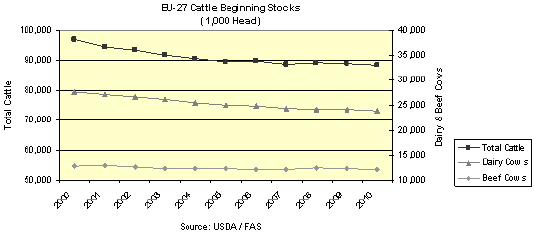
After the temporary upturn, the EU cattle herd is forecast to resume its long term trend of contraction. This trend is mainly a result of increasing costs for land, feed and energy, lagging milk prices, and restricted government support. Calf production in 2008, 2009, and 2010 is adjusted slightly downwards from the forecast in the Annual Report (GAIN Report NL9022). Ending inventories as well as slaughter are revised to a lower number accordingly. After a reduction of 2.1 per cent in 2008, the calf crop is expected to decline 1.5 per cent in 2009 and 0.8 per cent in 2010. During 2008 - 2010, the EU cattle stock is projected to fall from 89 million head to 88 million head. Throughout the EU, the smaller farms with only a few cows are abandoning the sector, while the biggest and most efficient farms are expanding. Due to the plummeting milk prices, the dairy herd is estimated to have been cut by 1.8 per cent in 2009. The oversupply of milk cows is reflected in their price development (see graph below). The beef cow herd is expected to have shrunk by only 0.4 per cent during last year. Carcass prices are supported by the limited beef supply from Brazil, which benefitted beef intra-trade, and beef export opportunities to Switzerland and Russia. Cattle exports are revised upwards as exports to mainly Northern African destinations recovered after have been limited by Bluetongue Disease related trade restrictions.
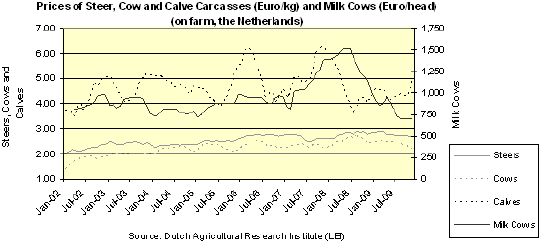
EU disease situation
Bluetongue disease remains widespread, decreasing fertility rates and calf per cow ratio, but most EU commercial herds have acquired immunity through past infections as well as from vaccinations. Food and Mouth Disease appears to be under control and BSE cases also continued their steep decline from recent years. The EU Animal Health Plan for 2010 provides funding for continued monitoring and combating of these and other major livestock diseases (see GAIN report E49088 - EC animal disease eradication, control and monitoring programme for 2010).
Beef
2009 & 2010 EU beef market contracted due to limited supply and the recession
As a result of reduced production and imports, the EU domestic beef supply fell drastically in 2008 (see the two graphs below). The limited imports are due to sanitary restrictions laid down by the European Commission (EC) on EU beef imports from Brazil in January 2008 (see GAIN Report E48016 and policy section). Due to the limited number of farms regaining eligibility to export and the strong Real, imports from Brazil recovered only marginally during 2009. Another factor is the economic slowdown in the EU.
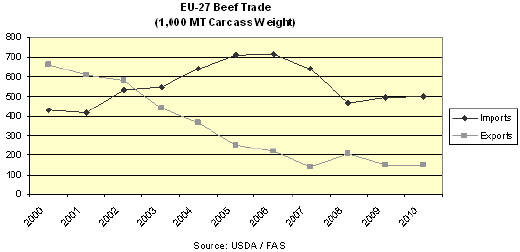
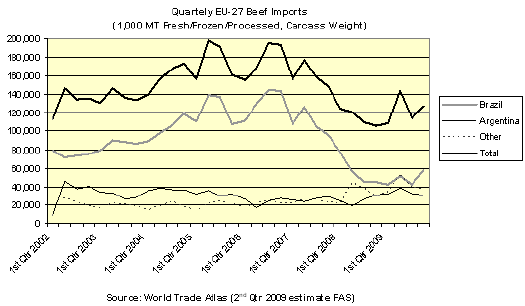
While the domestic demand for beef in Brazil continues to grow, EU consumers cut down their beef consumption. As a consequence of this variety of factors, EU importers believe that imports from Brazil will remain constrained during 2010. Through 2009, increases were reported for imports from Argentina and to a lesser extent from Uruguay, Australia and the United States. While the supply from Uruguay, Australia and the United States is expected to grow further, imports from Argentina are anticipated to be limited due to cattle shortages and export restrictions imposed by the Argentinean government.
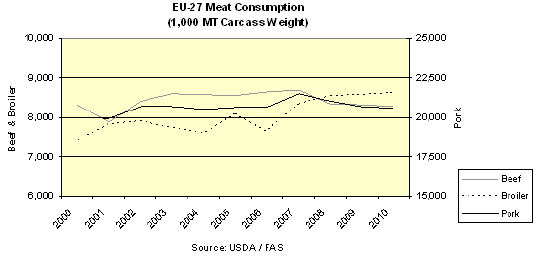
Brazilian beef exports to the EU
On 31 January 2008, the EC imposed stricter traceability requirements for Brazilian beef imports, which in practice banned Brazilian beef from the EU market (see GAIN Report E48016). Based on an audit conducted in January-February of 2009, the EU Food and Veterinary Office (FVO) reports that progress has been made but remains critical of the Brazil animal identification and traceability system. The list of Brazilian cattle farms approved for export to the EU has increased to about 2,000. This is, however, only a fraction of the 6,780 Brazilian farms which had been certified during 2007.
Update on the new EU beef import quota for high quality beef
The details for the administration of this new 20,000 MT beef quota were published in Commission Regulation (EC) No 620/2009[1] . This US - EU hormone compromise deal was formally approved in Council Regulation (EC) No 617/2009 [2] , published in the Official Journal on 15 July 2009. The quota has been imposed on 1 August 2009, for a period of two years. With mutual agreement the quota will possibly be enlarged to 45,000 MT after this period. The 20,000 MT quota is a small part of EU beef consumption, but it is a significant opening into the high-end beef market. During 2006 – 2008, EU imports of US beef tripled from 2,100 MT to 6,400 MT. With this new quota, US beef exports to the EU grew further to nearly 9,000 MT in 2009, with a value of 107 million USD. The quota is not expected to be filled during the first year. During the first six months after the opening, sales of US beef amounted to nearly 7,000 MT. But this new duty free quota has induced Australia to also file for access, which was granted by publication [3] on 20 January 2010. While the supply from Australia is believed to be limited, expectations are that the quota will be filled in the second year.
[1] 1] http://eur-lex.europa.eu/LexUriServ/LexUriServ.do?uri=OJ:L:2009:182:0025:0030:EN:PDF
[2] http://eur-lex.europa.eu/LexUriServ/LexUriServ.do?uri=OJ:L:2009:182:0001:0001:EN:PDF
[3] http://eur-lex.europa.eu/LexUriServ/LexUriServ.do?uri=OJ:C:2010:013:0011:0011:EN:PDF
Further Reading
| - | You can view the full report by clicking here. |
March 2010


